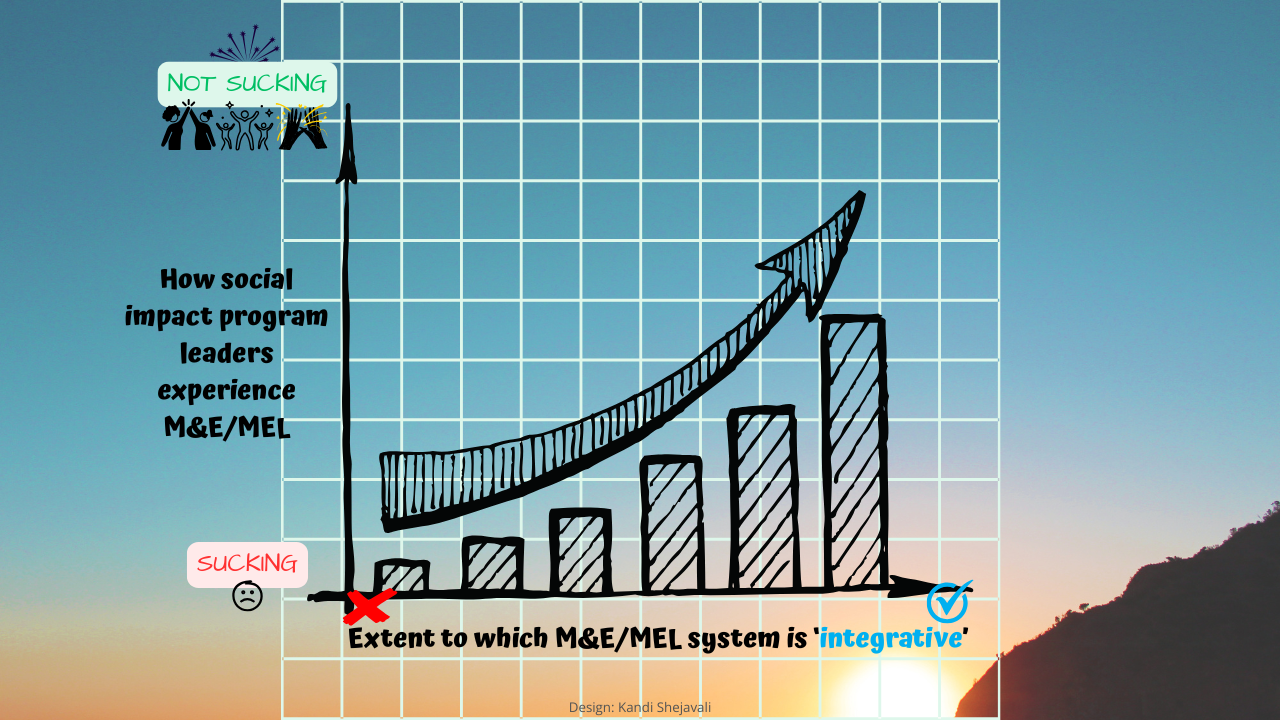This is a ‘problem’ I no longer have in my ToCs
Apr 03, 2023
I’m a stickler for the inclusion of a problem statement in a program or project’s theory of change (ToC). I roll my eyes any time I came across a ToC that lacks this critical element.
Given what the ToC represents (see the quick explanation below, if necessary) —
Quick aside: Let’s back up a sec. What is a ToC? A ToC is “serves as a roadmap for a [program or project]” (Shejavali, 2021a), laying out the pathway that the program will follow to achieve the desired results.
—, one would expect a statement describing the problem that the program or the project is trying to address to appear within the ToC every time.
But surprisingly often, the problem statement is lacking from ToCs (meaning that I probably roll my eyes a lot more often than is healthy…). I still come across ToCs that start out with the program’s inputs and activities and how those will lead to the desired results…without a whisper of the initial problem that the program or project is meant to tackle.
So what if the problem statement is missing?
The reason I feel so strongly about including a problem statement in the ToC is many-fold.
First and foremost, it helps get everyone on the same page not only about the situation that the program aims to tackle but also about the underlying drivers of that problem.
Beyond being of value in and of itself, documenting those root causes aids in the refinement of the program or project’s focus and its mechanisms. For example, a program could address the problem of biodiversity loss in multiple ways, depending on which underlying cause its stakeholders felt was most pertinent.
- For some, the focus might be on ensuring adequate financing for nature-positive interventions.
- Others might deem it more relevant to sensitize policy makers and citizens around the world to the importance of changing the current global economic order that prioritizes economic growth above all, which leads to even environmental economists viewing nature as just one of any number of factors of production in service of increasing GDP.
Stated differently, various programs could address the same overarching problem in different ways, based on problem analysis and related sub-analyses and the cause deemed to be most relevant to tackle. Based on which element of the problem tree the program aims to tackle, a team that’s best equipped to tackle that specific element could then be put together.
Aside from helping increase clarity and transparency around what the program is trying to address, including a credible problem statement in a program or project’s ToC also helps:
- expose hidden assumptions;
- reflect consensus (assuming that a key criterion for a robust ToC — that it is meaningful to and supported by intended participants, affected populations, and result enablers — is respected);
- ensure that program team members and other stakeholders pull in the same direction (thus reducing the potential of working at cross-purposes); and
- enhance creativity in developing solutions to the selected underlying cause of the problem.
Snapshot of key elements included in the ToCs I used to develop
This is a full list of the key elements that would be included in the ToCs I used to develop for my clients:
- problem;
- input and activities;
- outputs;
- outcomes (often broken down into intermediate and longer-term outcomes); and
- impact.
The problem statement would reflect an articulation of the main problem along with its key underlying causes. Through visual cues, attention would be drawn to the sub-cause being tackled by my client’s program or project.
A change of heart: no more ‘problem’ in the ToCs I develop
How I do things now
About a year ago or so, I started doing things differently. Instead of labeling the section of the ToC that contains the problem analysis ‘problem’, I adopted the term ‘opportunity for change’. So now the ToCs I develop include the following key elements:
- opportunity for change;
- input and activities;
- outputs;
- outcomes (often broken down into intermediate and longer-term outcomes); and
- impact.
The ‘opportunity for change’ section still reflects an analysis of the problem, but you typically won’t see the word ‘problem’ appear anywhere. (“Typically” because, well, one has to adapt to clients who might insist of using this terminology. Who knows, maybe they were convinced of the importance of doing so by M&E specialists who are like the former me…argh, karma bites…!)
Not just a simple matter of semantics
Given that the substance of the former ‘problem’ and current ‘opportunity for change’ section of the ToC remains the same, one might argue that it’s a simple matter of semantics. In other words, that I’m just trying to put a more positive packaging on the same old product.
And yes, true, it places a more positive spin to a word loaded with negative connotation.
But beyond this, I really do think that the shift reflects, and advances, something more profound.
First of all, it helps bring focus to the vision of the type of society we want to see. After all, M&E is “really about demonstrating how close or how far we are from the type of society we want. It’s about bringing about effective change. It’s about envisioning an ideal world and then charting a path to making that a reality – durably” (Shejavali, 2021b).
This vision is often implicit but is sometimes made explicit.
- For example, in international development, the most explicit form of this is the current set of sustainable development goals (SDGs) (which, in my opinion, carry some problematic elements…but that’s an article for another day). The SDGs were adopted by all the member states of the United Nations in 2015 (United Nations, undated).
- As another example, in national development, policymakers often lay the dream out in long-term vision statements and medium-term national development plans (also sometimes problematic…also a topic for another discussion).
Furthermore, viewing the world from the angle of what we’d ideally like to see helps us identify opportunities for change in more places than we might otherwise and helps deepen program impact. I don’t (yet) have empirical evidence of this — I’ll report back when I do! —, but it seems to make sense as an echo of the popular adage ‘change your mind, change your life’. We really do experience and act on things differently when we take on a different perspective.
I liken it to the difference between taking in a view from behind the lens of a camera to putting the camera down and just taking in the view.
Labeling the problem analysis ‘opportunity for change’ harnesses M&E’s immense potential to help transform the world. After all, “we know an intervention can be designed and implemented in ways that can help spark or increase the potential for transformative change” (Ofir in Kehrer, 2020). Doing so via the ToC, even if just through better labeling of its elements, is a small but important step in the right direction.
There is so much more to say on the topic, but I’ll end there for now.
Conclusion
Relabeling the ‘problem’ in a ToC to ‘opportunity for change’ is more than a matter of semantics. It reflects, and can lead to, a profound shift in how social changemakers view and tackle the challenges that they seek to address through their programs and projects.
Over to you!
PRACTICAL TIP #1: Review your program or project’s ToC. Does it include a credible (i.e., based on relevant research and experience) problem analysis? If so, and if that section of the ToC is labelled ‘problem’, sense what relabelling it ‘opportunity for change’ does for you.
PRACTICAL TIP #2: If you’re not already doing so, consider periodically revisiting your program or project’s ToC to review not only the problem analysis (or to add one if it is not already included) but to review the ToC as a whole. Conduct this review with the meaningful participation of program participants (and other affected populations), program partners, and other individuals and entities with an interest in the project. The key question to ask during this review is whether the ToC meets the criteria to be considered robust.*
[*RELATED RESOURCE: If you’re not clear on what the criteria for a robust ToC are, see Step 3 in the guide towards a practical and effective M&E system, available via TolaData’s website: https://www.toladata.com/blog/widen-your-m-and-e-horizon-with-specialist-kandi-shejavali-part-2/ (once you get to the page, just click on the words “special gift”).]
PRACTICAL TIP #3: Together with the program or project’s stakeholders, see what subtle or not-so-subtle shifts occur when you label the problem analysis section of the ToC ‘opportunity for change’ rather than ‘problem’. Mull on this for a while (interpret ‘for a while’ as you wish…this could extend overnight or over a few days, weeks, or months), and see whether any new insights come up.
Update of 3 May 2023: Please share your experience by commenting or leaving an emoticon reaction at the bottom of this LinkedIn post or by hitting ‘reply’ to any of RM3’s emails (and if you’re not receiving our emails, join the list by signing up here or by requesting access to a free resource).
References:
Ofir, Z. (2020, September 29). Forward to Guest post: Getting ready for transformational projects. Evaluation for Transformation blog. https://zendaofir.com/guest-post-getting-ready-for-transformational-projects/# (accessed: 3 April 2023).
Shejavali, K. (2021a, September 7). A new theory for the theory of change (or how an M&E tool can capture the broader change we want to see). LinkedIn Pulse. https://www.linkedin.com/pulse/new-theory-change-how-me-tool-can-capture-broader-we-want-shejavali (accessed: 3 April 2023).
Shejavali, K. (2021b, March 12). Rethinking M&E. What is it to you? LinkedIn Pulse. https://www.linkedin.com/pulse/rethinking-me-what-you-kandi-shejavali (accessed: 3 April 2023).
United Nations. (undated). The 17 Goals. Web page. https://sdgs.un.org/goals (accessed: 3 April 2023).
Photo credit:
(Photo credit: Drew Beamer on Unsplash)
Suggestion for how to cite this article (using APA 7 style):
Shejavali, K. (2023, April 4). This is a problem I no longer have in my ToCs. Blog post. RM3 Consulting. Available at: https://www.rm3resources.com/blog/this-is-a-problem-I-no-longer-have-in-my-ToCs (accessed: [insert the date that you last accessed this article at the link provided]).





